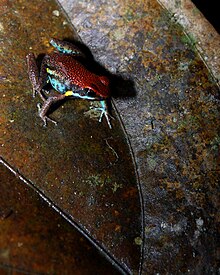Ameerega bilinguis
The Ecuador poison frog or Ecuadorean poison frog (Ameerega bilinguis) is a frog. It lives in Peru, Colombia, and Ecuador.[2][3][1]
| Ameerega bilinguis | |
|---|---|

| |
| Scientific classification | |
| Domain: | Eukaryota |
| Kingdom: | Animalia |
| Phylum: | Chordata |
| Class: | Amphibia |
| Order: | Anura |
| Family: | Dendrobatidae |
| Genus: | Ameerega |
| Species: | A. bilinguis
|
| Binomial name | |
| Ameerega bilinguis (Jungfer, 1989)
| |
| Synonyms[2] | |
| |
Body
changeThe adult male frog is 16.5–20.2 mm long from nose to rear end and the adult female frog is 18.6–22.7 mm long. The skin of the frog's back is black in color with red marks. The belly is light blue in color with black stripes. The sides of the body are black with a light blue stripe. There is more blue color towardthe rear end. The tops of the feet are dark gray in color. There are yellow marks near where the legs meet the body. The iris of the eye is black in color. The sides of the head are black with some blue marks.[3]
Name
changeScientists gave this frog the Latin name bilinguis because its call has two parts.[3]
Home
changeThis frog lives on the ground in forests. People see it on the dead leaves on the ground near streams in forest that has never been cut down and in forest that has been destroyed and is growing back. They can live in places that flood for part of the year, but only during times when they are not flooded. Scientists saw the frog between 125 and 800 meters above sea level.[1]
Some of the places the frog lives are protected places: Parque Nacional Yasuni, Reserva Biólogica Limoncocha, and Reserva de Produccion Faunística.[1]
Young
changeThe female frog lays eggs on dead leaves on the ground. She lays 4 to 16 eggs at a time. They are about 2 mm across. The male frog watches the eggs. The eggs take 18 to 22 days to open. After the eggs hatch, the male frog carries the tadpoles to pools of water or to streams that move slowly, where they swim and grow.[1]
Danger
changeScientists say this frog is not in danger of dying out. Humans change the places where the frog lives. People cut down forests to make farms and to get wood to build with.[1]
References
change- ↑ 1.0 1.1 1.2 1.3 1.4 1.5 IUCN SSC Amphibian Specialist Group (2018). "Ecuador Poison Frog: Ameerega bilinguis". IUCN Red List of Threatened Species. 2018: e.T55215A61396034. doi:10.2305/IUCN.UK.2018-2.RLTS.T55215A61396034.en. Retrieved November 28, 2024.
- ↑ 2.0 2.1 Frost, Darrel R. "Ameerega bilinguis (Jungfer, 1989)". Amphibian Species of the World, an Online Reference. Version 6.0. American Museum of Natural History, New York. Retrieved November 28, 2024.
- ↑ 3.0 3.1 3.2 Luis A. Coloma; Diego A. Ortiz; Santiago R. Ron; Caty Frenkel; Cristina Félix-Novoa; Irene Oña (June 25, 2013). Santiago R. Ron; Luis A. Coloma (eds.). "Ameerega bilinguis (Jungfer, 1989)". AmphibiaWeb (in Spanish). University of California, Berkeley. Retrieved November 28, 2024.
